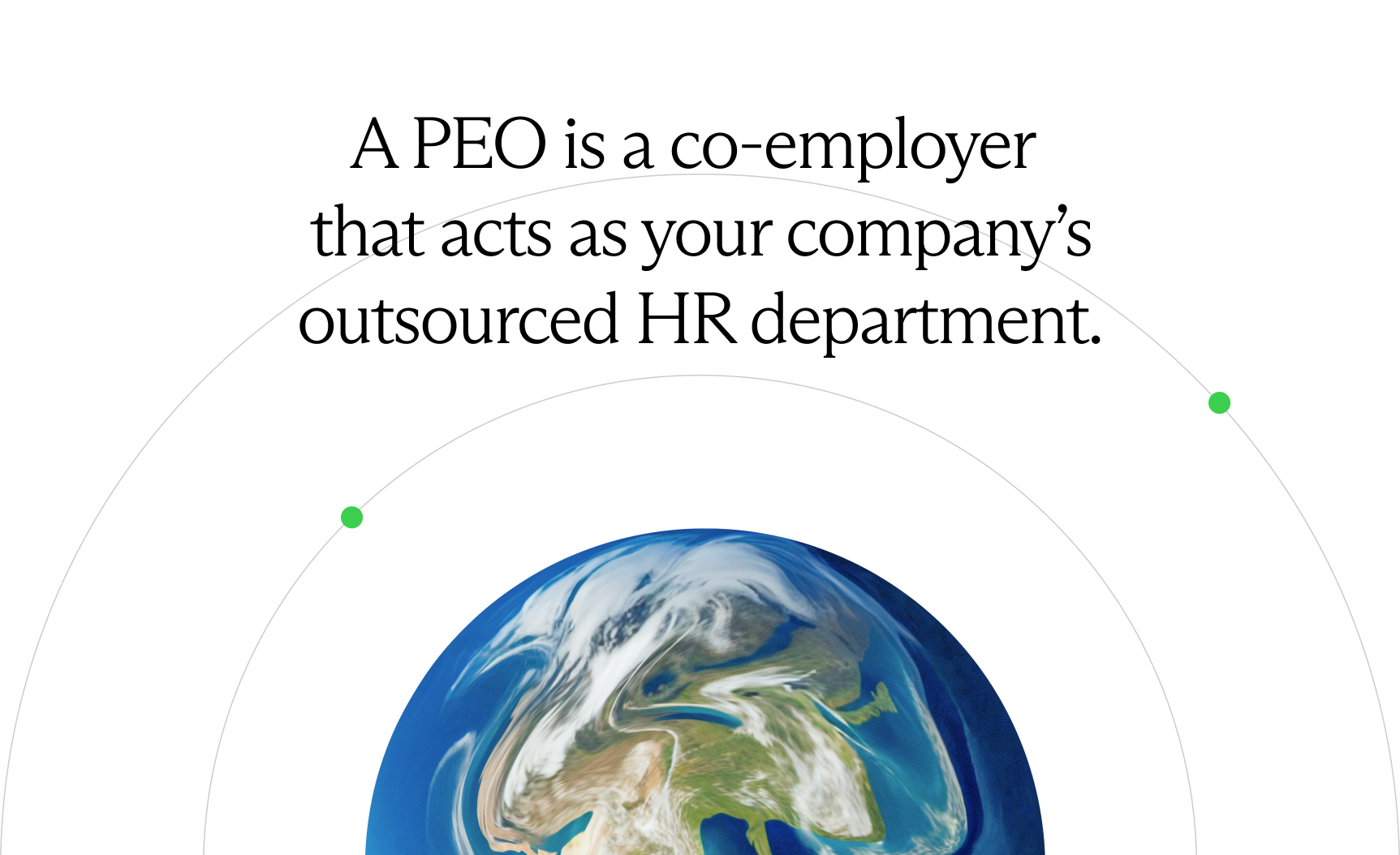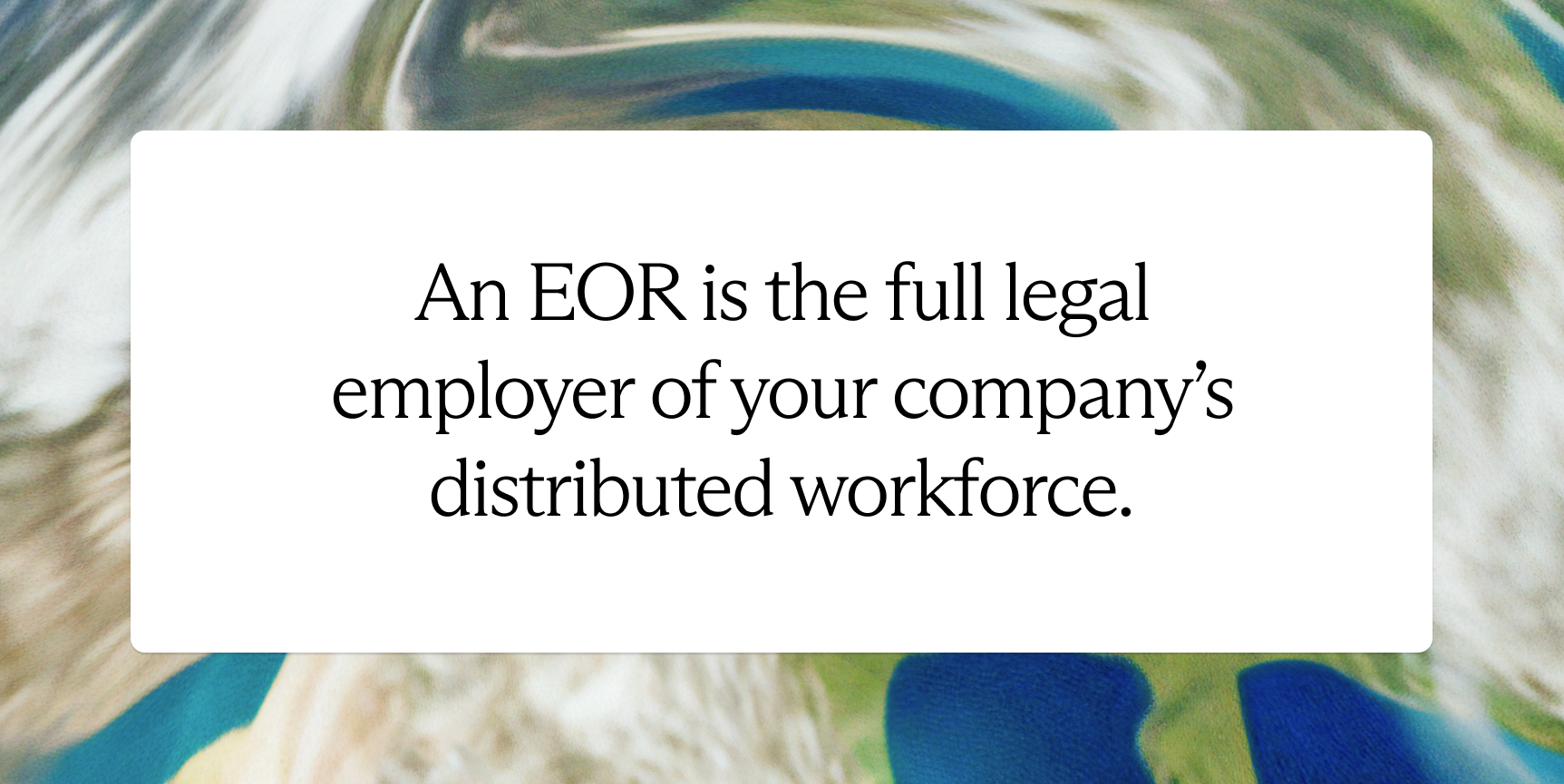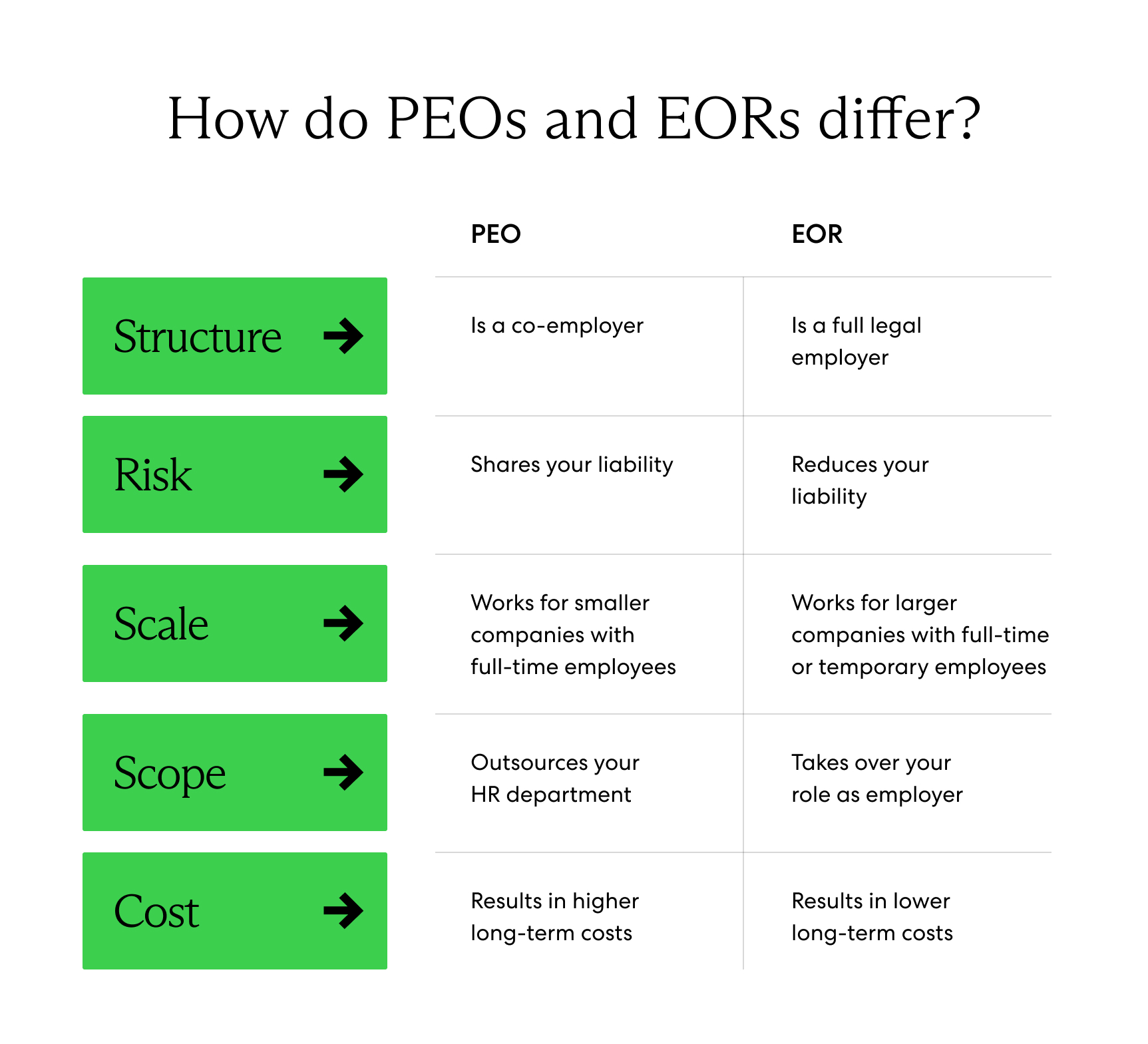Employer of record (EOR) and professional employer organization (PEO) partners help companies manage teams across the world. The main difference between PEO vs. EOR is that a PEO acts as a co-employer, while an EOR is the legal employer of an organization’s distributed workforce.
Understanding this and other differences between a PEO vs. EOR is the first step to choosing an ideal solution for your company’s complex talent needs.
Agile companies need novel solutions to quickly and compliantly build their distributed workforce. It’s no wonder that many teams look beyond their surrounding market to find and hire remote talent across the country or the globe.
However, hiring and paying across borders requires compliance with local employment laws—a time-consuming and tedious process.
Let’s explore need-to-know information about PEOs and EORs, their key differences, and critical decision-making factors when choosing a solution for your organization.
What is a PEO?

A PEO is a company that partners with small and medium-sized businesses to provide comprehensive HR services. Businesses that need help hiring full-time, permanent employees in their local area often choose PEO partners to offload tasks like:
- Payroll processing
- Benefits administration
- Regulatory compliance
- Tax filings
PEOs act as a company’s outsourced HR department so that internal teams have more time to focus on their core tasks.
A PEO is a partner company and not the employer of your workforce. This means that working with a PEO relieves you of HR-related responsibilities, but your company is still held accountable for both legal and day-to-day operations—including registering your business where you hire talent.
What is an EOR?

An EOR, or sometimes called a global PEO, is a global employment organization that takes on all employer-related responsibilities for small to large enterprise-sized businesses in locations where they don’t own an entity. On paper, an EOR is the legal employer of your workforce. In reality, you maintain a similar relationship with your workforce as you would without an EOR.
An EOR handles complete HR-related tasks, such as:
- Locality-specific onboarding
- Payroll
- Taxes
- Payroll compliance
- Benefits administration
- Unemployment claim reporting
If your goal is to quickly and compliantly hire top talent no matter where they’re located, an EOR partner gives you the flexibility to easily enter nearly any market—no business registration required.
Working with an employer of record also gives you peace of mind knowing that experts compliantly handle every HR and employer-related responsibility, so your teams can focus on their core responsibilities. As a result, an employer of record reduces the time, hassle, and cost required to build a distributed workforce.
PEO vs. EOR: 5 key differences every organization should know

While an EOR and a PEO both handle HR functions for your company, the two are not the same. Here are five important differences that set EORs and PEOs apart.
1. Structure
A PEO is a co-employer, a third-party company that outsources your organization’s HR duties. An EOR, on the other hand, is a third-party company that employs your distributed workforce in areas where you do not own an entity.
With a PEO partner, your company is the on-site employer, and you have authority over HR-related decisions that a PEO partner would facilitate. With an EOR, you give up some control over HR-related decisions, but you do so with a trusted partner that offers access to high-quality benefit plans and local expertise.
2. Risk
Since a PEO is a co-employer, your organization will have exposure to employment liabilities like workplace safety. The PEO can likely help you manage those risks, but a PEO does not maintain full responsibility for workplace risks.
One benefit of an EOR is that it acts as the actual employer of your workforce and assumes all employment risks and liabilities related to the services it offers.
3. Scale
Because a PEO acts as a co-employer that takes on HR-related tasks, it may offer greater value to companies with more full-time rather than temporary employees. PEOs also may require a minimum number of employees in order to provide access to certain benefit packages.
An EOR, on the other hand, offers more flexibility for companies that rely on temporary employees or that need access to talent in other locations. EORs are also less likely to have employee minimums, meaning it’s possible to hire just one employee in a region.
4. Scope
A PEO partner offers HR services in locations where your business already owns an entity. Because a PEO does not employ your workforce, your company is still responsible for location-specific labor law compliance.
An EOR partner has comprehensive knowledge of local hiring practices and laws to take the compliance guesswork out of a multistate or multinational expansion.
5. Cost
PEOs and EORs both structure their rates similarly with up-front and long-term costs, often charging either a flat monthly fee per employee or a percentage of monthly payroll. A PEO might also have a one-time introductory charge to set up services.
An EOR generally costs less than a PEO in the long term. An EOR covers insurance and benefits for your distributed workforce, saving your organization additional money and time. With a PEO, you would still be responsible for insurance and benefits.
PEO partner or EOR partner: How to decide
With the differences between an EOR and a PEO cleared up, let’s break down three factors that will help you decide which solution is best for your business.
What's your workforce size?
Scaling for small businesses and startups costs a lot of money, especially when expanding and hiring in new locations. If your business is already planning to open a new entity in a new state or country, consider a PEO to join as a co-employer and manage HR-related tasks in your new locale.
If your business is looking to hire in a new locale or multiple countries at once, an EOR expedites the onboarding process and takes on the responsibility for labor law compliance.
How large is your company footprint?
If you don’t own separate entities in states or countries where you’re looking to hire new talent, you’ll face steep costs in establishing new entities and laying the groundwork to comply with local laws and regulations. Instead of launching those new entities or avoiding hiring talent in other locations, invest in an EOR partner that serves as an entity on your behalf and provides the foundation for compliant employment.
If you already own or are looking to establish an entity in a new location, a local PEO partner offloads HR services in that location so you can focus on managing your team.
Which solution should you choose?
Hiring top talent overseas is a complex and ever-evolving process. Adherence to unfamiliar labor laws and regulations is difficult and expensive, and a lack of global compliance leads to regulatory issues, costly fines, or penalties, and a loss of the top talent you set out to hire.
If your business needs to enter new markets quickly while avoiding entity establishment, Velocity Global can help.
Get in touch to learn how our Employer of Record (EOR) solution helps you compliantly onboard, pay, and manage employees in over 185 countries.



